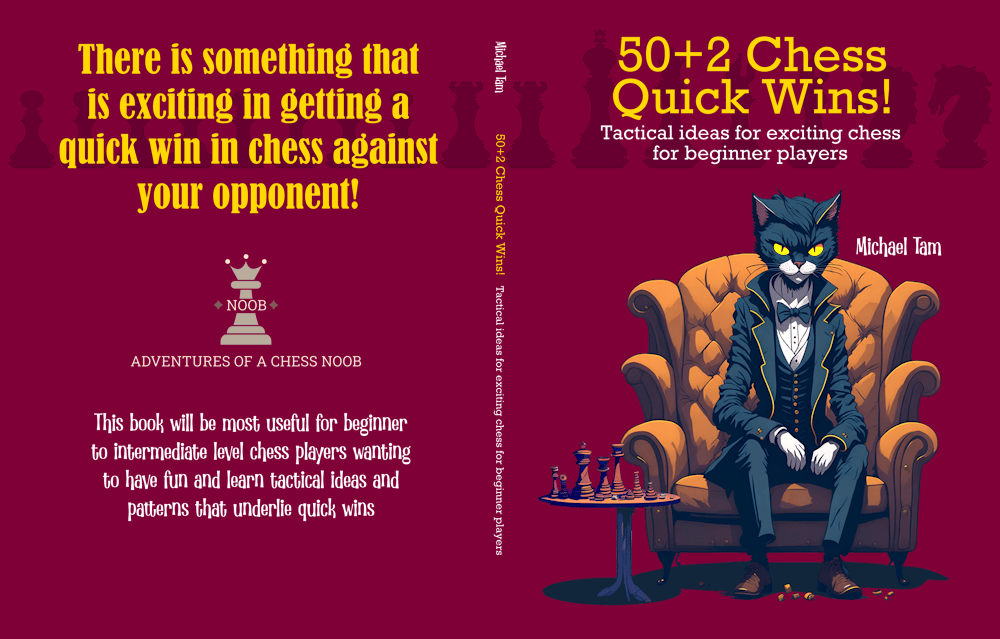
Brilliant Romantic ATTACK | Vienna Game: Main Line, Paulsen Attack 🤩
#romantic #vienna #rooksac #brilliant
I love playing aggressive, tricky, romantic manoeuvres! 🤩 To quote myself from the draft manuscript (about 40% complete!) of my upcoming book, from the perspective of the romanticist:
It is not enough to simply win, but one must strive to win with style!
– vitualis the chess noob
![]()
I had an epiphany some time ago on my chess journey that I don’t really play to win, but rather, I play to have fun! Now, I don’t play with the intention of losing, but I would definitely prefer to play a game of exciting and evocative chess, even if I lost, than play a dull and uninteresting game where I won mechanically. And thus, the name of my blog and channel – it’s the adventures of a chess noob! 😁
I had a really fun time with this following game, where I’d realised that I’d made a mistake in the opening, and so decided to play some tricky, high-risk, high-reward tactics, and was rewarded with a beautiful win. Let’s go!
I had the white pieces, and the game starts with the Vienna Game, my opponent from Türkiye knew the basics and brought us into the Main Line, to which I responded with the Paulsen Attack (1. e4 e5 2. Nc3 Nf6 3. f4 d5 4. fxe5 Nxe4 5. Qf3).
![]()
A historical note:
Louis Paulsen (1833-1891) was a German, and later American chess master who is considered one of the greatest theoreticians, and one of the strongest chess players in the later half of the 19th century. In the USA’s first major chess tournament of New York 1857, Paulsen was ranked second after Morphy! During the period of romantic attacking chess, Paulsen’s extensive opening analysis suggested that a defence was always possible, and as such, Black could always at least maintain neutrality, and should White’s attack be premature and fail, Black would capture the advantage. These theoretical ideas were unpopular at the time, but arguably, he was proven correct with Steinitz’s conversion towards advocating the positional style, and his subsequent success becoming the first world chess champion.

Paulsen’s theoretical contribution have resulted in his name being attached to variations of many openings. The Vienna Game: Main Line, Paulsen Attack was played by Paulsen himself against Englishman Joseph (“the Black Death”) Blackburne with success in (Paulsen — Blackburne, 1889, Breslau, Germany).
![]()
Black then played a move that I knew was likely inaccurate (5… Bc5?!), and it was, but I had a mental block on how to respond! Black’s bishop and their e4-knight both pressured my f2 square, so I had to do something… but after thinking for a minute, I didn’t feel any closer to definitively finding the correct solution, that I knew must exist.
Retrospectively on analysis, I realised that I had held an idea in my head that trading knights was bad, i.e., Nxe4, as a principle rather than a heuristic, which is contextually based on the assumption that Black plays accurately. Against Black’s inaccurate Bc5, removing one of the attackers of the f2 square was the best move. I did find the second-best move, which was to gambit another pawn – (6. d4?!). This blocked Black’s c5-bishop for a turn and forced them to capture (6… Bxd4), while it opened the diagonal for my dark square bishop to develop, and then force a bishop trade (7. Be3 Bxe3 8. Qxe3).
After this was played, I realised that although I had stepped out of an immediate danger, I was nonetheless behind. Black had won one of my pawns, I was left with an isolated e-pawn, and I didn’t seem to have much in terms of compensation. Stockfish’s evaluation agreed with my impression – in this part of the game, my opponent had an advantage of around [-1 to -2].
We played on and the early middlegame was a bit of an impasse. There was a tension between Black’s e4-knight and my c3-knight, and for several turns, neither of us were willing to initiate the trade. The position was complex, and it seems our mutual human intuition was wrong as the engine recommended for both of us to initiate the trade for advantage! 😂
Eventually I took the leap, but after a series of trades in the middle of the board, I once again recognised that I didn’t have the advantage. On move 16, Black opposite-side castled (16… O-O), and I began a risky and moderately ridiculous manoeuvre, that nonetheless worked out!
It started with (17. Nf5), placing my knight on a square that attacked Black’s g7-pawn/square, and gave control of the fully open d-file to my rook. In doing so, I knowingly hung my a2-pawn to Black’s queen on a5. My logic was that I was going to launch an attack on Black’s king, and sacrificing a pawn or two was possibly just the tempo I needed to make it work!
Black, expectedly, developed their rook to the e-file (17… Rfe8), threatening to reveal an attack on my queen on e4 by moving their e5-knight. And here, I found a tricky move with (18. Qd4?!) – this is technically a mistake [-3.3], but I’ve set up a major threat! Black’s knight is pinned to the g7-pawn as moving the knight would allow for Qxg7#!
Black captured my a2-pawn with their queen (18… Qxa2), giving me a step of tempo. And here, I played my last gamble with (19. Rde1?!), which is technically a blunder. If Black was looking at the position carefully, then they’d realise that immediately placing one of their rooks on d8 wins my queen! I cannot move my queen off the fully open d-file as Black would have checkmate with Qa1#!
However, my intuition was that Black would have (relative) tunnel vision having just moved their queen and would be primed to attack with their queen again with (19… Qa1+), and my prediction was right! Their logic was that by forcing my king onto the d-file, they would be able to absolute pin my queen to the king. Why would I allow this? Wheels within wheels!
After (20. Kd2) my only legal move, my rooks on the back rank attack Black’s queen on a1. Black could immediately attempt to pin my queen, but that would not be advantageous as I would also capture their rook after the queen trade. So, I had a one move reprieve and Black would need to move their queen first. Their best move is to give another check with (20… Qa5+), but this would require them to make the decision to give up their tactic of constructing the d-file absolute pin. That’s a hard choice to make, especially you don’t recognise the danger! Black instead, parked their queen on a “safe” square (20… Qa6??), I get a reversal, and this blunder by Black completely justified my attack plan!
With (21. Rxe5!) I take out Black’s e5-knight! Remember, this knight was pinned to g7. Now, moving my rook threatens checkmate-in-one! Black, however, probably thought there was no risk as they had (21… Red8), and it seems like they are just fast enough, pinning my queen to the king. That means checkmate isn’t possible right, as the queen cannot move off the d-file?
However, this pin is an illusion! The allure of winning my queen was too strong for them to resist, and this approach did hold true risk for me, but Black moved one step too slow. I sacrifice, THE ROOK! Black’s back rank was vulnerable and with (21. Re8+!!), a brilliant move according to the chess.com analytic engine, the trap is sprung, and the full tactic revealed! 🤩
Black has only one legal move, which is to capture the rook (22… Rxe8). In doing so, the White queen is unpinned, and she delivers the coup de grâce with (23. Qxg7#). Good game, GG!
The big takeaway from this game is to try playing romantically. Look beyond the limited mental framing of winning and losing and play for enjoyment and fun. Attempt a tactic because the payoff is beautiful and become comfortable with the risk. After all, in casual games what does it really matter to lose some ELO?



